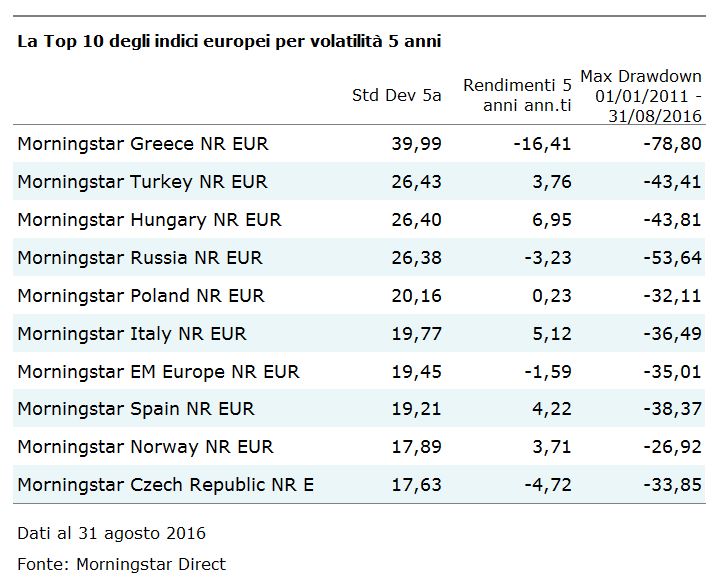For the show this year, I left one day free just to roam freely around the show, looking for some insights or random bonus stories. One of the things that piqued my interest upon entering the International Tent was a number of VR headsets. It could be argued that the headsets that require a smartphone are a dime a dozen, so I scouted around for the VR headsets that were designed to come contained as all-in-one units and offer an untethered experience. A couple of the big names are touting untethered VR, so I asked around at a number of booths to look into the cheaper side of VR. For $ 100, you don’t get a lot.
For an all-in-one Virtual Reality headset, the core components include the screen resolution, screen size, screen quality, the SoC, the memory, the battery, the connectivity (wireless/LTE, USB etc.), the feel and the function of the headset are all key factors to get it right. In the myriad of six/seven headsets I was able to find in a morning at IDF, it was clear that almost all of these areas are gutted into the low-performance rung in order to meet very strict price points.
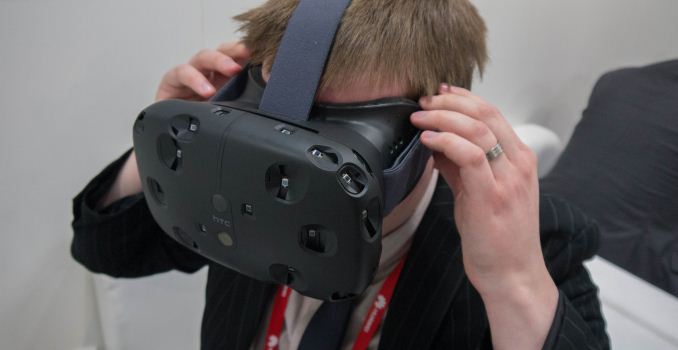
If we nostalgically look back to when Oculus was just starting, there were some clear defined goals that had to be achieved. For the most part they revolved around being to use the headset, eliminate nausea, and provide an immersive user experience. Millions of dollars and several prototypes later gave us the Rift, along with the Vive and other head-mounted displays (HMDs) that rely on a super powerful system behind it.
On the other side is Samsung Gear VR, leveraging an already owned premium smartphone with a reasonable element of a headset to house it – the smartphone is at a similar power budget to what you would expect to be the limit in front of the face. What these ‘bargain basement’ headsets try to do is try to provide all the hardware inside the headset, similar to the Gear VR, including SoC and battery and everything else, but for the same price as the Gear VR (minus smartphone). Of course, at the other end is Google Cardboard.
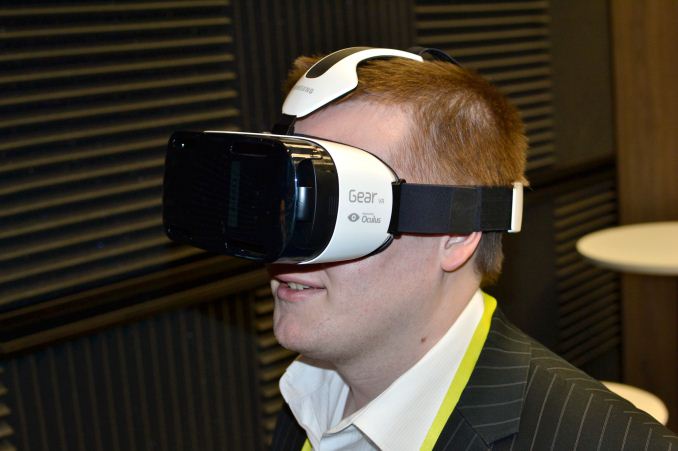
The true comparison points to these all-in-one VR systems could be the backpack VR units that house a laptop-like device, but these still require cables. The better comparison is to Intel’s Project Alloy, announced at IDF, or Qualcomm’s new VR820 platform, however both use internal and external cameras as part of a mixed VR/AR concept called mixed reality. We’ve seen other things like the SulonQ, which uses older AMD embedded parts, to provide the horsepower for an untethered VR experience as well. But all three of these are premium devices still in development. The goal of these cheaper headsets is to be super low cost, which also means there’s lots of competition to shave tenths of a cent off of the production costs.
As an additional caveat, the makers of these headsets I found on the show floor are the original design manufacturers, or ODMs. They are looking for bigger companies to order thousands of units and brand them under their own name, and subsequently deal with sales and distribution.
#1: Feihong Industry Company Limited and the FXH-09
The first AIO-VR (all-in-one virtual reality HMD) was actually one of the better ones out of the set. For $ 100 sample price, coming down to $ 75 on 3000+ orders, the headset uses a Rockchip RK3288 SoC which we’ve seen in tablets before. It’s a four-core ARM Cortex-A17 design, running at up to 1.8 GHz, with Mali T760MP4 graphics. It barely powers a tablet, so you can imagine it does wonders in an AIO-VR.

Aside from the SoC, the headset uses a single 5-inch IPS Full-HD display, similar to a smartphone unit. The display actually quotes 72% NTSC, with 60 Hz and 1000:1 contrast ratio (I should be so lucky). The 2GB/16GB arrangement is on the low end, and to my surprise (or perhaps not) there is only 802.11n in this model, and I would bet that it is single stream as well. Battery comes in at 4000 mAh.

Other specifications include a mini-HDMI port, micro-USB for charging, 5V/2A charging supported, a bundled Bluetooth joypad, and a total device weight of 460g. It’s worth noting that this headset, like a number of others in this list, uses a modified version of Android. The Nibiru variant seems designed for VR interaction in this case.
The design is simple, as one might expect from an ODM (it’s up to the OEM/reseller to add the flair), and this headset goes above a number of others in this list – we have separate controls for IPD (inter-pupillary distance, as in the distance between the eyes because everyone is different) as well as screen positioning for eye-lens-screen focusing. The lenses move as one unit for IPD adjustments, in and out, but that is more than most.
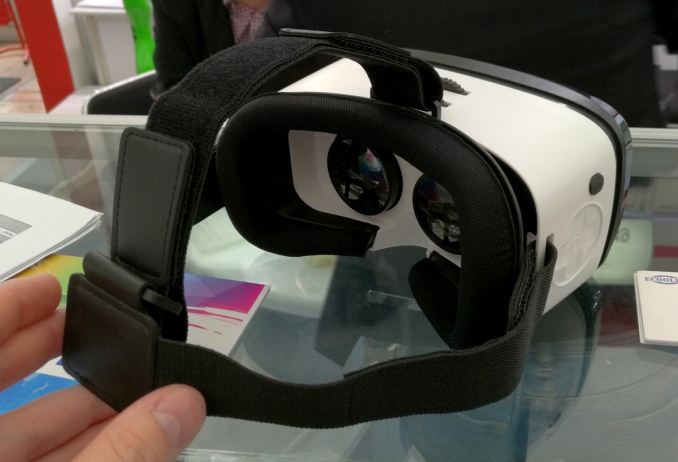
There’s no counterweight on the rear, meaning that the whole 460 grams rests on the face, and the design uses the side pad for in-scene adjustments. The nose grip at the bottom certainly wasn’t complete, letting in light; however I was told that again it can be an OEM adjustment.
If it’s $ 75 for the OEM, by the time it hits the market it would be at least double that, once a few stickers, logos and distribution is added.
#2: rftech VRA009
If you have ever wanted to look like Geordie LaForge from Star Trek, the rftech might have something cheap enough for a bad costume. The VRA009 is their ODM solution, striking at the heart of the low cost.

It’s all in the specifications: an Allwinner F1C100A, which is a single ARM9-based 32-bit core ARM926EJ-S solution with an integrated VPU in the back end, but the dual 800×480 screens might be the catch. Fair play in actually using dual 3-inch Sharp LCD panels giving a total 800×960 resolution, but I wonder which would struggle the most: understanding the low pixel environment or the low-end GPU stretched to the limit.

The marketing image on the side showed a picture of the Hulk in the field of view, and quoted 3D play time of 4 hours, with an integrated ‘real 3D player’. I wonder if that’s 3D in the sense of pseudo applied 3D, or actual 3D content – but not the 120 Hz stuff as I’m pretty sure these are 30/60 Hz panels. Other specifications were not present, I was told I’d be sent a press kit but none arrived at the time of posting.

The black on blue visor look draws the eye to the design, and the AIO-VR puts all the buttons on the bottom. We get a full directional pad, a power/return button, a micro-USB for charging, and a slider indicating ‘2D/3D1/3D2’, which I can only assume is a slight adjustment for the lenses depending on the mode it is in. There is no IPD adjustment, with the lenses being fixed.
The inside of the VRA009 was also bathed in light when equipped (hunting for VR at these shows is like an RPG), with the leatherette surround instantly feeling uncomfortable and obviously prone to inducing sweat over long periods.
In this case, I’m sure that rftech is pitching this device purely for media content consumption. I doubt it could pass even basic 3D interactivity without inducing nausea, but that’s something that you have to play with when it comes to cheaper VR headsets.
#3: OMG Electronic Limited
No name for this particular AIO-VR, and no specs either, but it does a new thing that the other headsets haven’t done so far – per-eye IPD adjustments.
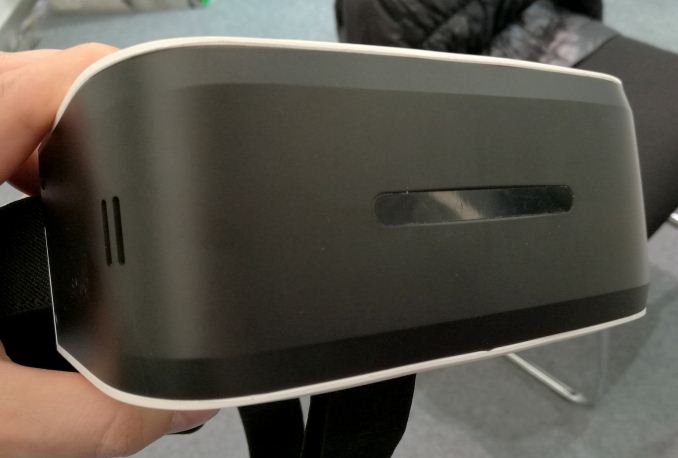
The styling is a basic black surround over a white chassis, which seems to be a common theme with these headsets. There’s space for the OEM/reseller to slap a logo on the front, and all the buttons are placed at the top.
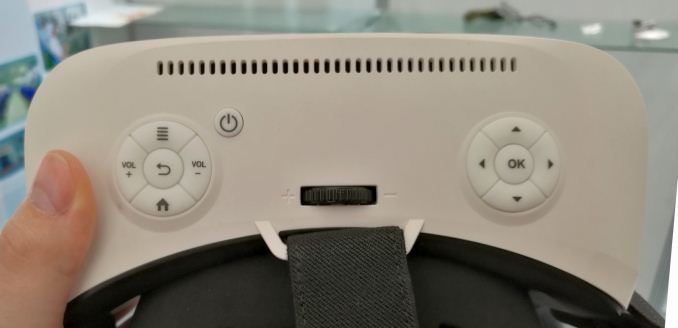
Dual directional pads cater for practically everything in a very simple ‘here are some Android buttons and a d-pad’ implementation. The power button is extremely close to the volume down button, so I can imagine a user quite easily fumbling for it and accidentally turning the hardware off. Oops.
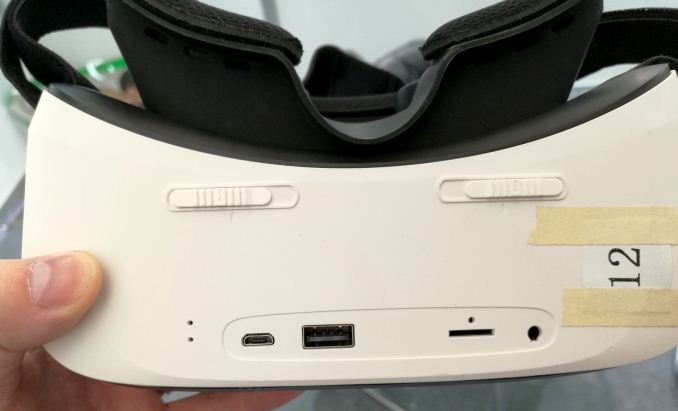
The bottom has the IPD adjustment sliders, and they were actually very smooth in their operation. When in position, tilting the headset did not adjust the arrangement, which is good to see (and something I might fear from a cheap headset). The bottom of the device also has a USB port, a microSD card slot, a 3.5mm jack for audio and what I believe is a mini-HDMI port as well.
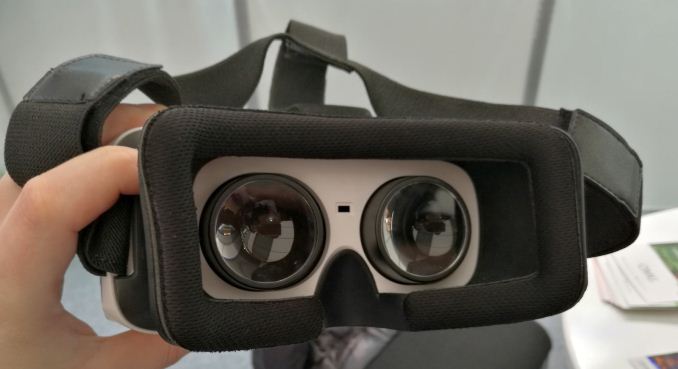
Inside, the lenses look substantial bits of PMMA (polymethylmethacrylate) plastic, as there would be no glass here, with a woven spongy surround that feels a lot better than the leatherette of other devices. Again, there’s no real nose guard for stray light, leaving it up to the reseller to sort out.
#4: Shenzhen Winbest Company Limited, VR102 + VR106
The only company to offer two SKUs, even with different designs, was the Shenzhen Winbest Company Limited. The lower end model, the VR102, uses a full 720×1280 5-inch IPS display with Android 5.1 powered by an RK3126 quard (sic) core SoC. This is a Rockchip design, built on a 40nm process, featuring quad ARM Cortex-A7 cores up to 1.3 GHz and a Mali-400 MP2 GPU. The AIO-VR has 1 GB of DDR3L memory and 8GB of storage which can be supplanted with a microSD card. To top it off, there’s a 2600 mAh battery.
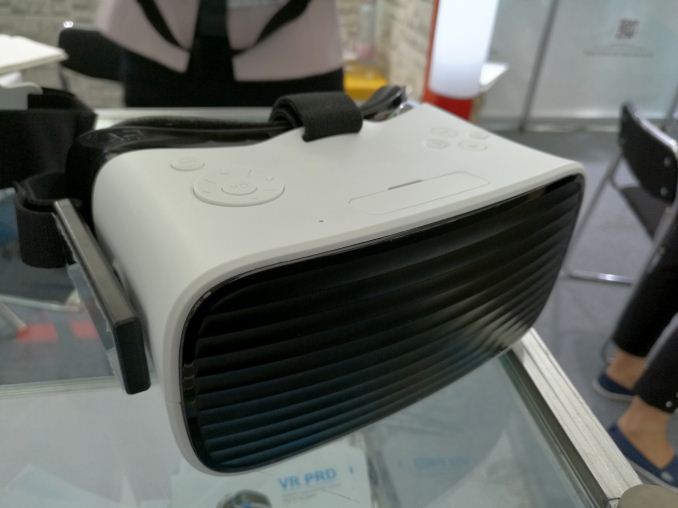
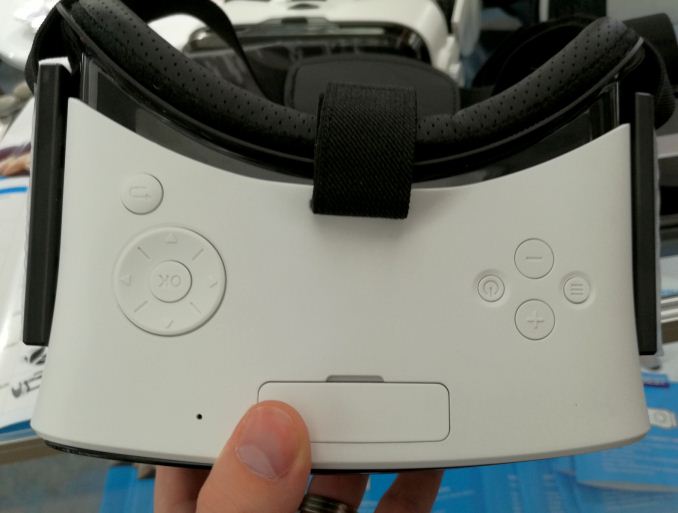
The design for the VR102 is a white chassis with a black face plate, with the system using a directional pad on the top with a separate four buttons for power, menu, and plus/minus. The headset uses a breathable foam/leather mix, and suffers the same face as the other headsets so far.
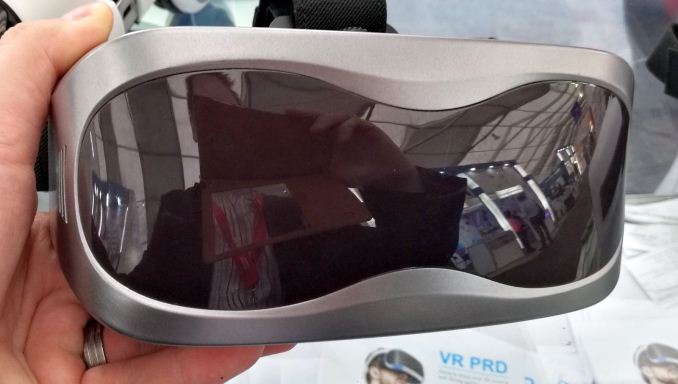
The upgraded model uses the same Rockchip RK3288 as the first AIO-VR in this list, but the screen is listed as a 2560×1440 display at 5.5-inches combined with a 2GB/16GB memory and storage configuration. The Nibiru OS makes another showing here, and the battery is updated to 4000 mAh. The design is aimed to be a little bit more polished than the lower grade headset, with an integrated HDMI input (or is that output?).
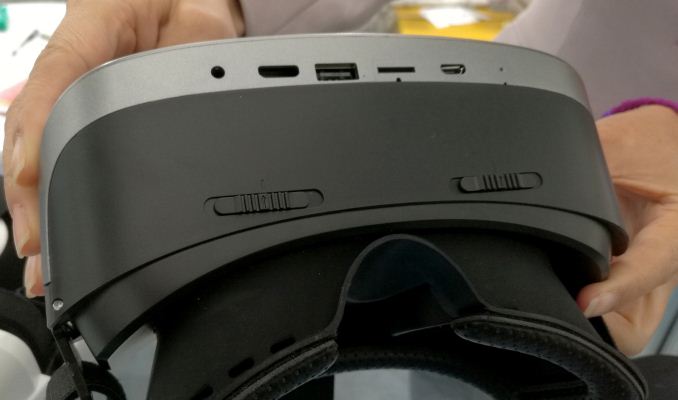
The VR106 had separate IPD adjustments on the bottom of the headset, along with what seems to be the usual array of outputs.
#5: EyeSun Technology Company Limited
No basic details or specifications on this one, aside from the 2600 mAh battery and a 4 hour rated lifespan. It only had one image around the booth about the hardware and the representative couldn’t tell me anything apart from ‘it’s still a prototype’. The look was interesting, so I snapped a few images.
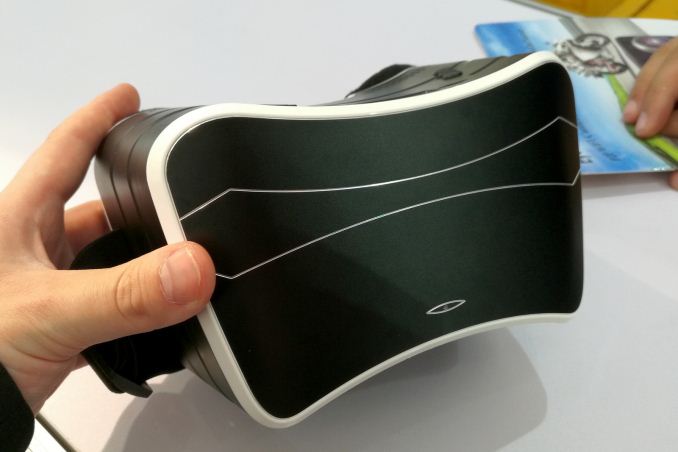

This is no IPD adjustment on these, as we have the same foam/breathable padding around the face with a big gap for the nose. Button placement was on the bottom, showing a directional pad, buttons to switch from 2D to 3D, a microSD card slot, a USB port, a 3.5mm jack, and what looks like a micro-HDMI port.
#6: Hena Digital Technology (Shenzhen) Company Limited VR501
Another device that in many ways mirrors the first one on this list. Under the hood is a Rockchip RK3288, meaning quad-core A7s up to 1.8 GHz and Mali T760MP4 graphics, which is combined with a 1920×1080 IPS screen, Android 5.1, and a WiFi module capable of 802.11n at 2.4 GHz.
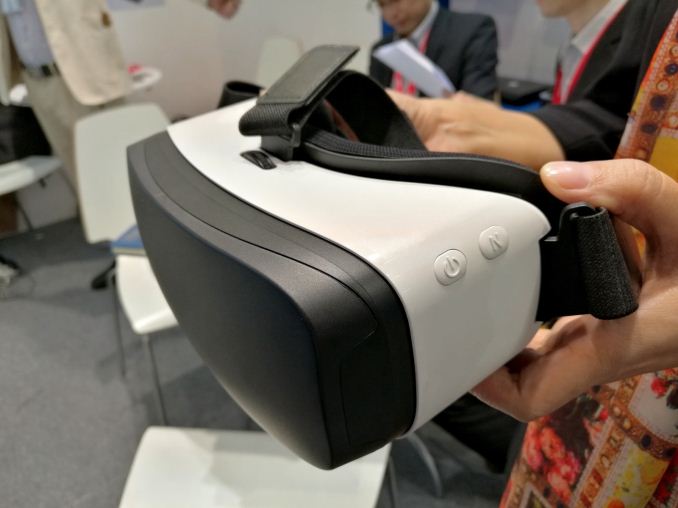
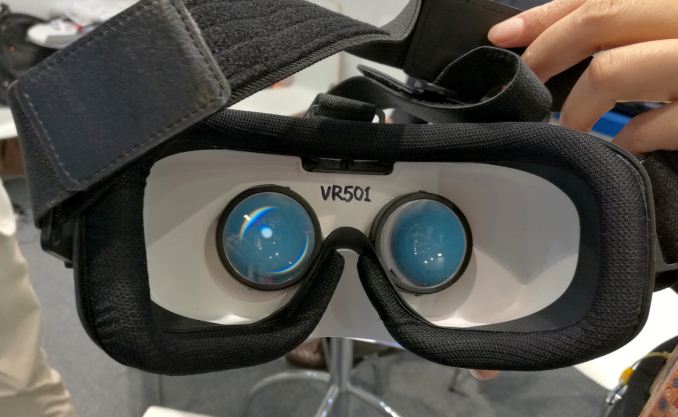
Also similar to the first, we got a sense of pricing. I was told that a single sample is $ 102, with price scaling based on order quantities.
However, there is no IPD adjustment on this headset, but at least the nose area is semi-sealed from the light. This one was actually working and had the Nibiru OS preloaded. The screen was very laggy, and it was clear from even basic motion it was going to cause a large deal of discomfort. These AIO-VRs are clearly for base content consumption, and anything moving is just a bad experience.
In the last few minutes of the show I was steered towards the Skyworth booth in a different hall and told to go see their all-in-one headset. I was told that in comparison to the others, the Skyworth offering might be a substantial substitute above the cheap VR on display. The problem is always the cost, which we’ll get onto in a minute. The Skyworth VR setup was on display to test, however there were no specifications on display, and we weren’t allowed to take a picture of the image on the demonstrator’s phone that had all the hardware listed, but I was able to memorize a few key points.
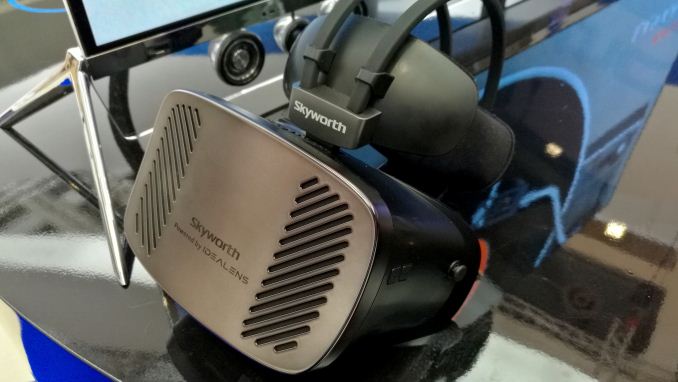
It’s worth saying that the Skyworth AIO-VR was slightly bulkier than the other headsets, if only because the mechanism to mount it on your head was a plastic part of the design, aimed at balancing the weight a little but also securing it more firmly with padded guards. The outside was still plastic, however with a brushed metal look, and slightly more attention to detail.
The units were up and powered, and after putting it on I could tell the interface was smooth. Don’t get me wrong, the pixels were still quite obvious, but moving my head showed a high frame rate display better than the 30/60 Hz offerings of the cheaper implementations.
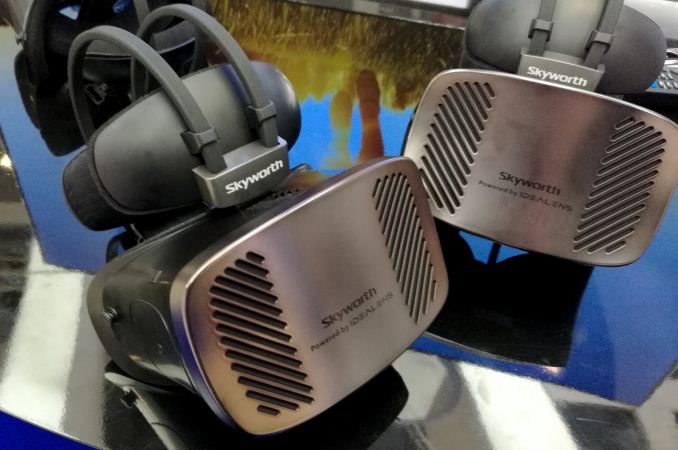
As far as I could jot down in a reasonable time, the headset uses an Exynos 7420, which is a 4×4 big.Little design using quad ARM Cortex A57 at 2.1 GHz and quad ARM Cortex A53 cores at 1.5 GHz on a 14nm process. The 7420 also uses Mali-T760MP8 graphics, at 772 MHz, which is good for 210 GFLOPs, and is paired with dual-channel (2×32-bit) LPDDR4. This SoC was powering dual 1080×1200 displays inside, which is a formidable number of pixels, and I saw that we’re looking at a 3800 mAh battery. Other specifications I can’t remember, though one would assume a 4GB/64GB arrangement for memory and storage if this was a smartphone.
So here’s the thing: the Skyworth headset is essentially a smartphone under the hood that you can’t take out. So what makes it better than a Samsung VR headset where the smartphone can be attached / detatched? One would assume it’s a price thing, and we were told the price for the headset could be $ 400 to $ 800. I remarked that it was a pretty large range, but was told that the Skyworth headset is still a work in progress, with exact specifications to be decided later. If it was $ 400, it might be more palatable, but for $ 800 then it might be easier to go the smartphone route.
The Problem with Low Cost VR
This brings us around to the problem with VR right now. Everyone wants in on the bandwagon, and in a keynote at the event it was pointed out that in order for triple-A style games and film studios to start making content in these new formats, there needs to be more potential sales out there. Current estimates put 500k headsets in the market (of varying degrees of power) with another 2.7 million by the end of 2017. No game studio or film studio, working on the next FPS or Avatar, will make a massive piece of content for only 3.2 million people – it needs to be in the hands of tens of millions to even start to make sense, and we won’t be at that point for a number of years.
All that being said, you have a choice – investing in a premium VR headset to be able to experience the best will cost $ 700+, in terms of the headset itself plus any extra hardware you need to power it. The easiest way to enter the VR space with some clout is the smartphone or all-in-one route, but that is still a hefty cost. Then there is a large, long gap to the segment of very basic all-in-one virtual reality headsets as shown at IFA this year.
For $ 100, or the rough price of the Samsung headset without any internal hardware, you get a basic quad-core Rockchip design with limited functionality. I’m half inclined to suggest that a bucket be provided as well, just in case nausea takes over. But it shows what a state VR is in, when the hardware is still so expensive. In order to get a base experience that can truly be called VR, such as with the Skyworth headset, it might be as much as a high-end smartphone anyway. For mass market adoption, the cost to enter has to be low, but not so low we’re scraping the barrel for basic frame rates.
Picture Galleries



